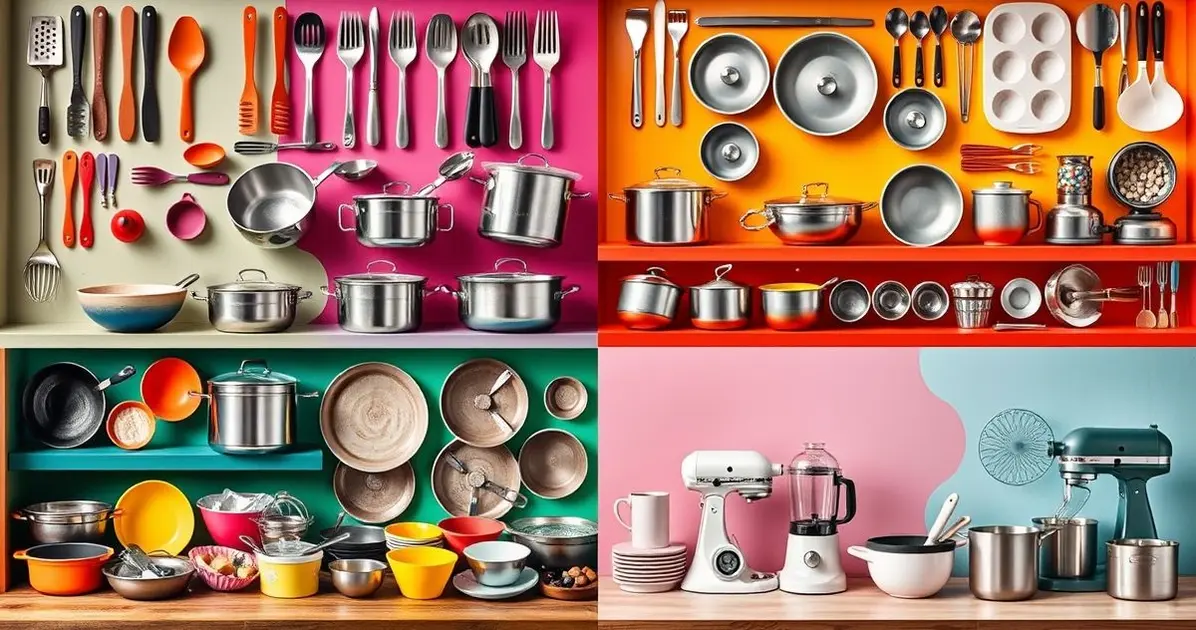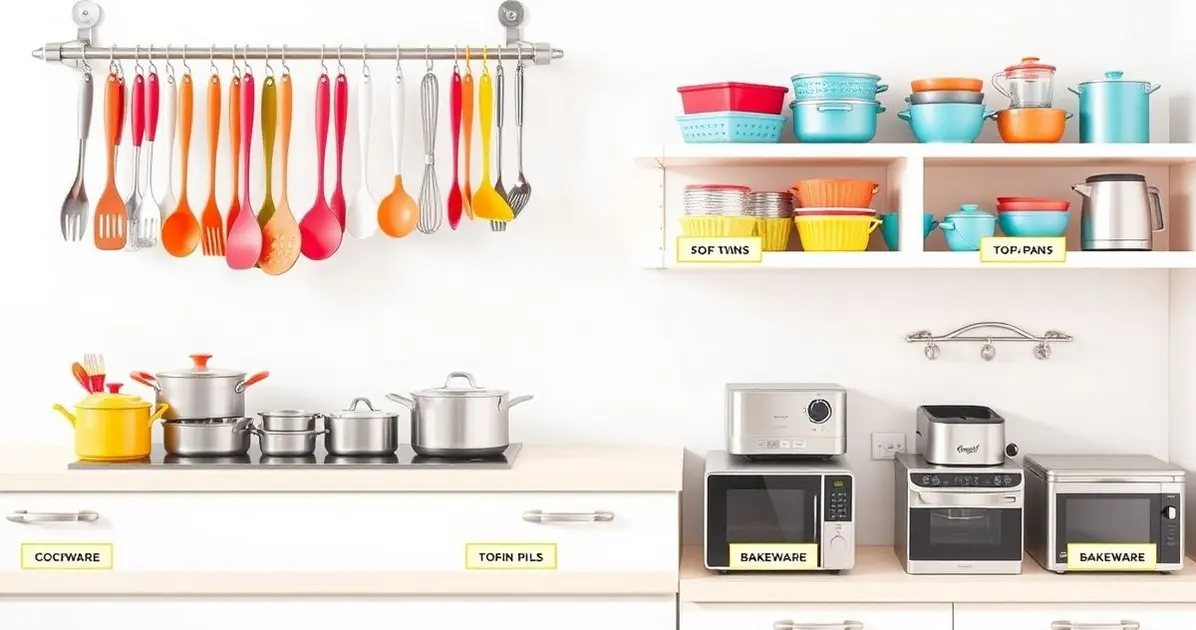Cooking tools and equipment can be classified into four main categories: utensils, cookware, bakeware, and appliances. Each plays a crucial role in the culinary process, enhancing efficiency and creativity in the kitchen.
What are the four classification of cooking tools and equipment

The four classifications of cooking tools and equipment include utensils (for mixing and serving), cookware (for stovetop cooking), bakeware (for baking delicious treats), and appliances (for food preparation and processing). Understanding these helps in selecting the right tools for culinary tasks.
Overview of Kitchen Utensils
Kitchen utensils are essential tools that aid in food preparation and cooking. Having the right utensils can enhance your cooking experience and improve efficiency in the kitchen. Here’s an overview of kitchen utensils that every home cook should have:
1. Chef’s Knife:
- Versatility: The chef’s knife is a multipurpose tool used for chopping, slicing, and dicing a variety of ingredients. Its broad blade allows for a rocking motion, making it ideal for quick and efficient cutting.
2. Paring Knife:
- Precision: A paring knife is smaller than a chef’s knife and is perfect for intricate tasks such as peeling fruits and vegetables or removing seeds. It offers greater control for detailed work.
3. Cutting Boards:
- Safety: Cutting boards provide a safe surface for chopping and slicing. It’s advisable to use separate boards for raw meats and vegetables to prevent cross-contamination.
4. Mixing Spoons:
- Material Variety: Mixing spoons come in various materials, including wood, silicone, and stainless steel. They are essential for stirring and combining ingredients.
5. Spatulas:
- Types: Spatulas come in various forms, including turners for flipping food and rubber spatulas for scraping bowls. A good set of spatulas is essential for cooking and baking tasks.
6. Whisks:
- Mixing and Aerating: Whisks are ideal for beating eggs, mixing batter, and incorporating air into mixtures. They come in various sizes and materials to suit different tasks.
7. Ladles:
- Serving Soups and Sauces: Ladles are perfect for serving soups, stews, and sauces. They allow for easy portioning and serving of liquid-based dishes.
8. Tongs:
- Versatile Handling: Tongs are handy for flipping, turning, and serving food. They provide a secure grip on ingredients and are especially useful for grilling, frying, or tossing salads.
By equipping your kitchen with these essential utensils, you can enhance your cooking efficiency and make food preparation more enjoyable. Each utensil serves a specific purpose, contributing to the overall success of your culinary endeavors!
Understanding Different Types of Cookware
Understanding the different types of cookware is essential for any home cook, as each type serves a specific purpose and offers unique benefits. Here’s an overview of different types of cookware:
1. Stainless Steel Cookware:
- Durability: Stainless steel is known for its strength and resistance to rust and corrosion, making it ideal for everyday use.
- Heat Conductivity: While stainless steel alone is not the best conductor of heat, many stainless steel pots and pans have an aluminum or copper core that improves heat distribution.
- Uses: Excellent for boiling, simmering, and sautéing, stainless steel cookware is versatile and easy to clean.
2. Cast Iron Cookware:
- Heat Retention: Cast iron retains heat exceptionally well, making it perfect for slow cooking and frying.
- Natural Non-Stick Surface: When properly seasoned, cast iron develops a natural non-stick surface that enhances flavor and cooking performance.
- Uses: Ideal for frying, baking, and braising, cast iron skillets and Dutch ovens are great for a variety of dishes.
3. Non-Stick Cookware:
- Convenience: Non-stick pans allow for easy cooking and cleanup, requiring less oil or butter for cooking.
- Ideal for Delicate Foods: Perfect for cooking delicate items like eggs and pancakes, non-stick cookware prevents sticking and ensures perfect results.
- Care: To preserve the non-stick coating, avoid using metal utensils and high heat.
4. Copper Cookware:
- Excellent Heat Conductivity: Copper cookware provides superior heat conduction, allowing for precise temperature control.
- Quick Response: It heats up and cools down quickly, making it ideal for tasks that require temperature adjustments.
- Uses: Great for sauces and dishes that require precise cooking temperatures.
5. Aluminum Cookware:
- Lightweight: Aluminum is lightweight and easy to handle, making it a popular choice for many home cooks.
- Good Heat Distribution: It heats up quickly and distributes heat evenly, making it ideal for frying and sautéing.
- Budget-Friendly: Aluminum cookware is often more affordable than other materials, offering good performance at a lower price point.
6. Ceramic Cookware:
- Non-Toxic and Non-Reactive: Ceramic cookware is free from harmful chemicals and does not react with acidic foods.
- Even Heating: It provides even heat distribution, making it suitable for baking and roasting.
- Care: Ceramic surfaces are typically non-stick and easy to clean, often being dishwasher safe.
By understanding the different types of cookware and their benefits, you can make informed decisions when selecting tools for your kitchen. Choosing the right cookware not only improves cooking performance but also contributes to the overall quality of your culinary creations!

Importance of Bakeware for Perfect Desserts
The importance of bakeware in creating perfect desserts cannot be underestimated. The right bakeware ensures that your baked goods turn out as intended, with the right texture and flavor. Here are some key points highlighting the significance of using appropriate bakeware for your dessert creations:
1. Even Heat Distribution:
- Material Matters: Different materials, such as glass, metal, and silicone, distribute heat differently. For instance, metal pans conduct heat well, providing even baking, while glass bakeware allows you to monitor the browning of your desserts.
- Consistent Results: Using the right bakeware helps achieve consistent results, preventing uneven cooking or burning.
2. Non-Stick Properties:
- Easy Release: Non-stick bakeware makes it easier to release cakes, brownies, and other desserts without sticking, ensuring they maintain their shape and presentation.
- Less Greasing Required: With non-stick surfaces, you often need less oil or butter, making your desserts a bit healthier.
3. Variety of Shapes and Sizes:
- Specialized Bakeware: Different desserts require specific shapes and sizes of bakeware. For example, round cake pans are ideal for layer cakes, while square pans are perfect for brownies.
- Customization: Using the right bakeware allows you to customize your desserts, creating unique shapes and presentations that enhance visual appeal.
4. Durability and Longevity:
- Quality Bakeware: Investing in high-quality bakeware ensures durability and longevity, allowing you to bake consistently over the years without worrying about wear and tear.
- Resistance to Warping: Quality materials, such as heavy-duty aluminum or ceramic, resist warping and can withstand high baking temperatures.
5. Easy Cleanup:
- Non-Stick and Dishwasher Safe: Many modern bakeware options are designed for easy cleanup, being non-stick and dishwasher safe, which saves time and effort after baking.
- Preventing Stains: Using appropriate bakeware also helps prevent staining and odors from lingering in your tools.
6. Enhancing Flavor and Texture:
- Optimal Baking Conditions: The right bakeware can influence the texture of your desserts, such as achieving a crispy crust on pies or a moist interior in cakes.
- Flavor Development: Proper bakeware allows for even cooking, which can enhance the flavors of your desserts by ensuring that all ingredients are cooked to perfection.
In summary, the importance of bakeware for perfect desserts is evident in its impact on heat distribution, ease of use, and the overall quality of your baked goods. By choosing the right bakeware for your dessert creations, you can ensure delicious results that impress family and friends!
The Role of Appliances in Streamlining Cooking Processes
Kitchen appliances play a crucial role in streamlining cooking processes, making meal preparation faster, easier, and more efficient. Here’s how various appliances contribute to enhancing your culinary experience:
1. Food Processors:
- Versatile Functionality: Food processors can chop, slice, shred, and puree ingredients in a matter of seconds, significantly reducing prep time.
- Time-Saving: With the ability to handle multiple tasks, food processors eliminate the need for manual chopping and mixing, allowing you to focus on other cooking tasks.
2. Blenders:
- Smooth Consistency: Blenders are perfect for creating smoothies, soups, and sauces, ensuring a smooth and consistent texture.
- Quick Mixing: They can quickly combine ingredients, making them ideal for dressings, marinades, and batters.
3. Slow Cookers:
- Convenience: Slow cookers allow you to prepare meals with minimal effort. Simply add ingredients in the morning, set the timer, and come home to a hot, ready meal.
- Flavor Development: Slow cooking enhances flavors as ingredients meld together over time, resulting in rich and delicious dishes.
4. Instant Pots:
- Multi-Functionality: Instant Pots combine several cooking methods, including pressure cooking, slow cooking, and sautéing, making them incredibly versatile.
- Time Efficiency: They significantly reduce cooking times for dishes that typically take hours, such as stews or braised meats.
5. Electric Grills and Griddles:
- Quick Cooking: Electric grills and griddles allow for fast cooking of meats and vegetables, providing a convenient way to prepare meals indoors.
- Temperature Control: Many models come with adjustable heat settings, allowing for precise cooking temperatures.
6. Rice Cookers:
- Perfectly Cooked Rice: Rice cookers take the guesswork out of cooking rice, ensuring perfectly cooked grains every time.
- Keep Warm Function: Many rice cookers come with a keep-warm function, allowing you to serve hot rice at any time without overcooking or drying it out.
7. Ovens and Convection Ovens:
- Even Baking: Ovens provide consistent heat for baking and roasting, while convection ovens use fans to circulate air for even cooking.
- Versatile Cooking Options: Ovens can be used for a variety of cooking methods, including baking, broiling, and roasting, making them essential in any kitchen.
In summary, appliances play a vital role in streamlining cooking processes, enhancing efficiency, and improving the overall cooking experience. By incorporating the right appliances into your kitchen, you can save time, reduce effort, and elevate your culinary skills, making cooking more enjoyable and rewarding!
Conclusion
In conclusion, understanding the role of appliances in streamlining cooking processes is essential for any home cook or culinary enthusiast.
The right kitchen appliances can significantly enhance efficiency, reduce prep time, and improve the overall quality of your meals.
From versatile food processors and blenders that simplify ingredient preparation to slow cookers and Instant Pots that make meal prep convenient, these tools can transform your cooking experience.
Additionally, specialized appliances like electric grills and rice cookers ensure perfect results with minimal effort.
By investing in and utilizing the appropriate kitchen appliances, you can save time, enhance flavors, and make cooking a more enjoyable and rewarding activity.
Embrace these tools to elevate your culinary skills and create delicious meals with ease!
FAQ – Frequently Asked Questions about Cooking Tools and Equipment
Ano ang mga pangunahing kagamitan sa pagluluto na dapat mayroon sa kusina?
Kabilang sa mga pangunahing kagamitan ang mga kutsilyo, cutting boards, pots at pans, utensils, at measuring tools.
Bakit mahalaga ang paggamit ng tamang kagamitan sa pagluluto?
Mahalaga ang tamang kagamitan upang mapabuti ang iyong karanasan sa pagluluto, matiyak ang kaligtasan, at pahabain ang buhay ng mga kagamitan.
Paano ko mapapanatiling malinis ang aking mga kagamitan sa pagluluto?
Magsagawa ng regular na paglilinis, gumamit ng mga ligtas na cleaning agents, at tiyaking tuyo ang mga kagamitan bago itago.
Gaano kadalas dapat suriin ang mga kagamitan sa pagluluto para sa wear and tear?
Dapat regular na suriin ang mga kagamitan, lalo na ang mga kutsilyo at non-stick cookware, para sa mga senyales ng wear and tear.
Ano ang mga tips para sa tamang pag-iimbak ng mga cooking tools?
Siguraduhing tuyo ang mga kagamitan bago itago, gumamit ng tamang storage solutions, at regular na suriin ang mga ito para sa wear and tear.
Paano ko mapapanatiling ligtas ang aking kusina mula sa foodborne illnesses?
Magsagawa ng regular na sanitization ng mga surfaces at kagamitan, at sundin ang mga best practices sa food safety.
See more
Discover plenty of easy and delicious recipes you can make at home, from hearty dinners to indulgent desserts and wholesome breakfasts.




